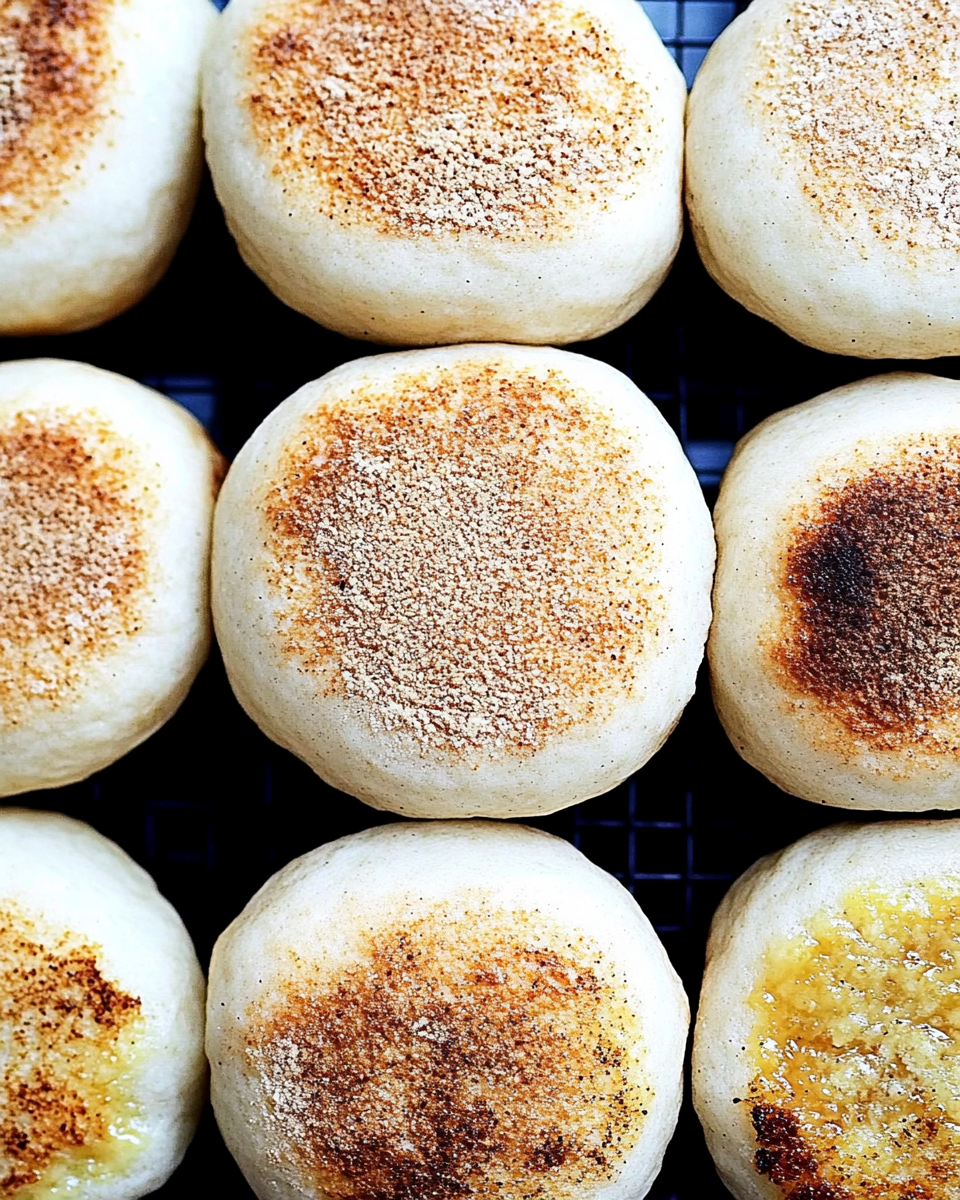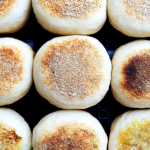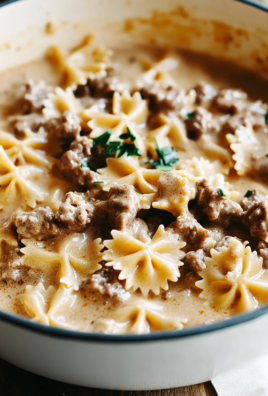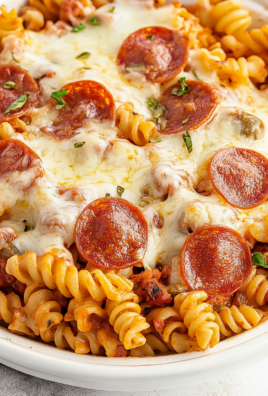Homemade sourdough English muffins are a delightful blend of chewy texture, tangy flavor, and those signature nooks and crannies perfect for holding butter, jam, or savory toppings. Unlike store-bought versions, these muffins are naturally leavened with sourdough starter, giving them a more complex flavor profile and making them easier to digest thanks to natural fermentation.
Whether you are an experienced sourdough baker or looking for creative ways to use your sourdough discard, these English muffins are approachable and rewarding to make. The dough comes together with simple ingredients, rests overnight for full flavor development, and cooks directly on the griddle for a crisp exterior and soft, airy interior.
These muffins are also freezer-friendly, meaning you can prepare a large batch and enjoy homemade breakfast bread any time. With their versatility, you can use them for breakfast sandwiches, eggs Benedict, or even as the base for mini pizzas.

Why You’ll Love These Sourdough English Muffins
- Naturally leavened for a superior tangy flavor.
- Packed with nooks and crannies, perfect for butter or spreads.
- No preservatives or additives, just simple ingredients.
- Ideal for using up sourdough discard, but works well with active starter.
- They toast up beautifully, with a crisp crust and soft, chewy center.
- Excellent for make-ahead meals — they freeze well and reheat quickly.
Essential Tools and Equipment
To make successful sourdough English muffins, having the right tools ensures consistent results. Here’s what you’ll need:
- Mixing bowls for combining ingredients.
- Stand mixer (optional) for easier kneading.
- Rolling pin to shape the dough.
- 3 to 4-inch round cutter (or a glass) for uniform muffins.
- Baking sheets for resting and rising.
- Plastic wrap or a damp kitchen towel to cover dough during fermentation and proofing.
- Griddle or cast iron skillet for cooking.
- Instant-read thermometer to check internal temperature (190°F is ideal).
These tools help achieve even cooking, proper rise, and the soft interior that defines a perfect sourdough English muffin.
Preparation Tips for Perfect Sourdough English Muffins
- Use an active, bubbly sourdough starter to achieve the best rise and flavor.
- Allow the dough to ferment overnight at room temperature, ideally 8 to 10 hours, so the flavor fully develops.
- Knead just enough to bring the dough together—over-kneading can make muffins dense.
- When rolling out the dough, aim for ½-inch thickness to ensure the muffins rise well on the griddle.
- Fork-split the muffins after cooking instead of cutting with a knife. This preserves the nooks and crannies.
- Monitor your griddle temperature carefully—too hot and the muffins burn before the interior cooks; too cool and they dry out.
Ingredients List
The Night Before (8 to 10 hours before cooking)
- 1 cup active sourdough starter (100% hydration)
- 2 tablespoons honey
- 2 cups milk (preferably room temperature)
- 4 cups all-purpose flour (unbleached)
The Next Morning
- 1 teaspoon baking soda
- 2 teaspoons salt
- 1 to 2 cups all-purpose flour (unbleached)
For Cooking
- Cornmeal, semolina, or farina for dusting
Step-by-Step Directions
The Night Before
- In a large mixing bowl, combine the sourdough starter, honey, milk, and 4 cups of all-purpose flour.
- Stir until a shaggy dough forms.
- Cover the bowl with plastic wrap or a damp towel.
- Leave at room temperature for 8 to 10 hours to ferment.
The Next Morning
- Add baking soda, salt, and 1 cup of all-purpose flour to the fermented dough.
- Knead the dough until smooth, about 5 minutes using a stand mixer or 10 minutes by hand. Add up to 1 additional cup of flour if the dough is too sticky.
- Let the dough rest for 10 to 15 minutes.
Shaping the Muffins
- Roll out the dough to about ½ inch thickness.
- Use a 3 to 4-inch round cutter (or a drinking glass) to cut out circles.
- Arrange the rounds on a lightly greased baking sheet dusted with cornmeal.
- Reroll the scraps to cut more rounds, making up to 18 smaller muffins or 9 larger muffins.
- Cover the muffins loosely with greased plastic wrap and allow them to rise for about 1 hour.
Cooking the Muffins
- Preheat a griddle to 325°F or heat a cast iron skillet over medium-low heat.
- Generously sprinkle the cooking surface with cornmeal, semolina, or farina.
- Place the muffins on the griddle, leaving space between them.
- Cook for 5 to 6 minutes per side, covering the pan if possible to encourage even cooking.
- Use an instant-read thermometer to check the internal temperature, which should register 190°F when fully cooked.
Serving Suggestions
Sourdough English muffins are one of the most versatile breakfast breads you can make. Their tangy flavor and chewy texture complement both sweet and savory toppings, making them a staple for any meal. Whether you enjoy them plain, toasted, or transformed into a hearty sandwich, they can easily become part of your regular breakfast rotation.
Here are several creative and classic ways to serve your homemade sourdough English muffins:
- Classic Toasted with Butter and Jam
Simply split the muffin, toast it, and slather with butter, honey, or homemade jam. The nooks and crannies soak up the toppings for a perfect bite. - Breakfast Sandwich
Fill your muffin with a fried egg, crispy bacon or sausage, and a slice of cheese for a hearty breakfast sandwich. - Avocado Toast
Top with mashed avocado, a sprinkle of salt, red pepper flakes, and a squeeze of lemon for a trendy, nutrient-packed meal. - Eggs Benedict
Use your muffins as the base for classic eggs Benedict, with poached eggs, Canadian bacon, and hollandaise sauce. - Open-Faced Smoked Salmon
Spread cream cheese on a toasted muffin, top with smoked salmon, red onions, capers, and fresh dill. - Sweet Treat
For a sweeter option, try peanut butter with banana slices, or ricotta with fresh berries and a drizzle of honey. - Mini Pizzas
Use leftover muffins as a pizza base, topping them with marinara sauce, cheese, and your favorite toppings before broiling until bubbly.
Side Dish Recommendations
Pairing your homemade sourdough English muffins with complementary side dishes can create a complete and satisfying breakfast or brunch spread. Here are eight excellent side dish ideas:
- Scrambled Eggs
Light, fluffy scrambled eggs make a classic pairing for sourdough English muffins, especially if served with butter and jam. - Greek Yogurt with Honey and Nuts
Balance the chewy, tangy muffins with creamy yogurt topped with crunchy nuts and a drizzle of honey. - Crispy Bacon or Sausage Links
Salty, savory meats contrast perfectly with the mild tang of the muffins. - Roasted Tomatoes
Warm, slightly caramelized tomatoes add a juicy burst of flavor alongside toasted muffins. - Fresh Fruit Salad
A medley of seasonal fruit brings freshness and color to the plate. - Potato Hash
Serve your muffins with a side of crispy potato hash for a hearty, comforting breakfast. - Smoked Salmon Platter
With cream cheese, capers, red onion, and lemon, this elegant spread is ideal for brunch. - Smoothie Bowls
For a lighter option, serve your muffins alongside a vibrant smoothie bowl loaded with fruit, granola, and seeds.
Common Mistakes to Avoid and How to Perfect Your Sourdough English Muffins
While sourdough English muffins are forgiving compared to other breads, a few common mistakes can prevent you from achieving the perfect texture and flavor. Here’s how to avoid those pitfalls:
Using an Inactive Starter
- Ensure your starter is bubbly and active before mixing the dough.
- Inactive starter can lead to dense muffins with little rise.
Skipping the Overnight Fermentation
- The overnight rest allows flavor to develop and improves texture.
- Shortening this step results in less complexity and a weaker rise.
Over-Kneading the Dough
- Knead only until the dough comes together smoothly.
- Overworked dough creates tough muffins.
Rolling the Dough Too Thin or Thick
- Roll the dough to ½ inch thickness for the right balance between height and interior texture.
- Thinner muffins won’t develop the signature nooks and crannies.
Skipping the Second Rise
- After cutting, the muffins need time to rise again to achieve a light texture.
- Skipping this rise can make muffins dense and chewy.
Cooking at the Wrong Temperature
- Low and slow cooking is essential.
High heat burns the outside before the interior cooks through, while too low heat dries them out. - Use a griddle thermometer if possible to maintain around 325°F.
Ignoring Internal Temperature
- Use an instant-read thermometer to ensure the muffins reach 190°F internally.
- This ensures they are fully cooked without over-drying.
Cutting with a Knife Instead of Fork-Splitting
- Use a fork to gently split the muffins after they cool.
- Fork-splitting preserves the irregular air pockets that hold melted butter and toppings.
Neglecting Proper Storage
- Allow muffins to cool completely before storing.
- Store in an airtight container or freeze to preserve freshness.
Perfecting your homemade sourdough English muffins takes practice, but following these guidelines helps you achieve muffins with a soft interior, crisp crust, and perfectly tangy flavor every time.
Expert Recipe Tips and Tricks
Achieving perfect sourdough English muffins relies on a few techniques that ensure the dough ferments well, rises evenly, and cooks with the signature texture English muffins are known for. Below are expert tips to help refine your process.
- Use an Active Starter for Best Rise
While sourdough discard can be used with yeast for a quicker process, an active, bubbly starter delivers the best flavor and structure. - Control Dough Hydration
Depending on the flour you use, you may need slightly more or less flour than the recipe calls for. The dough should be soft and slightly tacky, not dry. - Allow Time for Proper Fermentation
The overnight ferment is critical to develop tangy flavor and improve the muffin’s texture. Shortening this step reduces both rise and flavor complexity. - Use Semolina or Cornmeal Generously
Dusting the cooking surface prevents sticking and adds a subtle crunch to the crust. Semolina is particularly good for adding texture. - Monitor Griddle Temperature Closely
Keeping the griddle at 325°F ensures the muffins cook evenly inside and out. Too hot, and they burn; too cool, and they dry out before cooking through. - Fork Split for Nooks and Crannies
Instead of slicing with a knife, use a fork to split the muffins once they cool. This preserves the natural air pockets that hold butter and jam.
Proper Storage and Reheating Instructions
Storage Instructions
- At Room Temperature
Store fully cooled muffins in an airtight container at room temperature for up to 3 days. - In the Freezer
For longer storage, place cooled muffins in a freezer-safe bag, removing as much air as possible. Freeze for up to 1 month. - Prevent Sticking
Place parchment paper between layers to prevent muffins from sticking together in the freezer.
Reheating Options
- Toaster
Split the muffin and toast until crisp and warmed through. - Oven
Preheat oven to 350°F, place split muffins on a baking sheet, and heat for 5 to 7 minutes. - Skillet Reheat
For a more rustic touch, warm split muffins in a dry skillet over medium heat for 2 to 3 minutes per side.
Frequently Asked Questions
Can I Use Sourdough Discard for These Muffins?
Yes. If using discard, add 2 to 3 teaspoons of instant yeast to the dough to compensate for the weaker leavening power. This shortcut skips the overnight ferment and only requires about 1 to 1.5 hours of rising time.
What Flour Works Best for English Muffins?
Unbleached all-purpose flour is ideal for these muffins, as it provides the right balance of structure and tenderness. For a heartier muffin, substitute up to 25% whole wheat flour, though you may need slightly more liquid.
How Do I Get More Nooks and Crannies?
- Use a well-hydrated dough.
- Avoid over-kneading.
- Let the dough rise fully after shaping.
- Always split muffins with a fork instead of a knife.
How Long Do Homemade Sourdough English Muffins Last?
At room temperature, they last up to 3 days. In the freezer, they last up to 1 month if stored in airtight bags.
Can I Freeze Sourdough English Muffins?
Absolutely. Once cooled, wrap muffins tightly and freeze. Thaw at room temperature or pop directly into the toaster or oven to reheat.
Why Are My English Muffins Too Dense?
Common causes include:
- Inactive starter.
- Insufficient fermentation time.
- Over-kneading, which tightens gluten too much.
- Skipping or shortening the final proofing rise.
Should English Muffins Be Baked or Cooked on a Griddle?
Traditional English muffins are griddle-cooked. Baking produces softer muffins, while griddle-cooking creates a crispier crust and better-defined air pockets.
What Temperature Should I Cook English Muffins At?
Cook muffins at 325°F. This allows the interior to cook fully without over-browning the exterior.
How Can I Tell When Sourdough English Muffins Are Fully Cooked?
The muffins are done when an instant-read thermometer inserted into the center reads 190°F. They should also sound hollow when tapped on the bottom.
Conclusion
Making your own sourdough English muffins combines the art of sourdough baking with the simplicity of a griddle bread. Whether you prefer them for breakfast, brunch, or an afternoon snack, these muffins offer unmatched flavor, texture, and versatility compared to store-bought versions.
With a little practice, you can customize these muffins to suit your preferences, adjusting the size, toppings, and even incorporating add-ins like cheese, herbs, or seeds for extra flavor.
Plus, the ability to freeze and reheat them makes them ideal for meal prepping, ensuring you always have a homemade breakfast option ready. Once you taste the chewy texture, crispy crust, and tangy flavor of your homemade muffins, you may never buy store-bought again.
Whether you are a seasoned baker looking to expand your sourdough repertoire or a beginner ready to dive into fermentation, these homemade sourdough English muffins are the perfect place to start.
Homemade Sourdough English Muffins
Ingredients
The Night Before (8 hours before)
- 1 cup active sourdough starter 100% hydration
- 2 tablespoons honey
- 2 cups milk
- 4 cups all-purpose flour unbleached
Next Morning
- 1 teaspoon baking soda
- 2 teaspoons salt
- 1 –2 cups all-purpose flour unbleached
- To Cook the English Muffins
- Cornmeal semolina, or farina for dusting
Instructions
The Night Before
- In a medium bowl, mix the sourdough starter, milk, honey, and 4 cups of flour.
- Cover the bowl and leave it on the counter at room temperature for 8–10 hours, depending on the activity level of your starter.
The Next Morning
- Add baking soda, salt, and 1 cup of flour to the fermented dough.
- Knead the dough until smooth, about 5 minutes using a stand mixer or 10 minutes by hand. Add additional flour as needed if the dough is too sticky.
- Let the dough rest for 10–15 minutes.
Shape the Muffins
- Roll the dough out to about 1/2-inch thickness.
- Use a 3–4 inch round cutter (or a glass) to cut out circles.
- Place the rounds on a lightly greased baking sheet dusted with cornmeal.
- Reroll scraps to make up to 18 small muffins, or divide the dough into 9 pieces for larger muffins.
- Cover the muffins loosely with greased plastic wrap and allow to rise for about 1 hour.
Cook the Muffins
- Preheat a griddle to 325°F or heat a skillet over medium-low heat. Generously sprinkle the cooking surface with cornmeal, semolina, or farina.
- Place a few muffins on the griddle or pan at a time, leaving space between them.
- Cook for 5–6 minutes per side, covering the pan if possible to help cook evenly.
- Use an instant-read thermometer to check the internal temperature — the muffins should register 190°F when done.




Leave a Comment